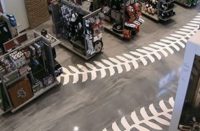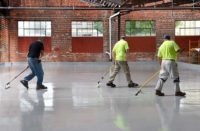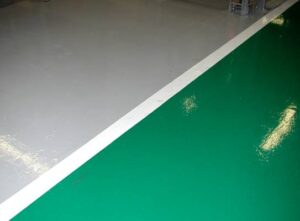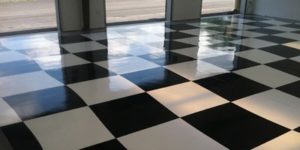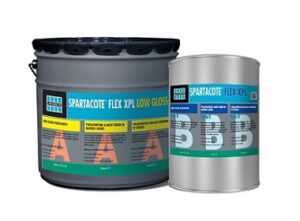When fire stations are upgraded, contractors must complete improvements while minimally disrupting operations and firefighters’ access to equipment. Oftentimes, the return-to-service window of products used is paramount to completing this task, especially when coating and sealing concrete apparatus bays.
Because epoxy coatings normally put a facility out of commission for three to seven days, an increasing number of fire stations are hiring contractors who use polyaspartic coatings and sealers that cure in an hour.
This trend is evident in the greater Pittsburgh metro, where two fire halls, and a medical rescue station, recently turned to locally based U-Neek Concrete Coatings and Flexmar, a manufacturer that introduced its polyaspartics to the market 10 years ago.
At the Ignomar Volunteer Fire Co. in the town of McCandless, Pennsylvania, U-Neek used solid color Flexmar polyaspartic coating and a semi-transparent, variegated polyaspartic stain sealer to create a look that resembled black smoke.
Prior to U-Neek’s work, the station’s 3,600-square-foot bay floors were bare, exposed concrete susceptible to absorbing dirt, grime, road salt and various leaking fluids from engines. The floors easily stained and also absorbed carcinogen-rich soot from equipment.
Epoxies weren’t the solution to the problem, says Geoffrey Allerton, a volunteer firefighter, as waiting for them to dry would cause the station dual problems. “We’d have to find another location for the trucks or let them stay outside,” he says. “But our trucks don’t lock.”
Additionally, if the firefighters couldn’t walk on the bay floors an hour after application, their access to staged equipment— water pumps, boots, hats— would be limited.
Thanks to U-Neek using Flexmar’s polyaspartics, the volunteers could walk on the floor and move equipment back within an hour of final application. Fire engines returned to the bays the next day.
A variegated process
Before rolling and hand applying coating and sealers, U-Neek’s crew diamond-ground the concrete to remove any contaminants that had been absorbed, creating a surface profile that would accept the coating system. Hairline cracks were also repaired.
A solid-colored base coat of White Night Grey Flexmar self-prime polyaspartic coating was then tightly rolled on the floor, drying in roughly an hour.
Applicators then worked to achieve random strokes with even shading while hand-applying a coat of Storm Cloud Grey Flexmar Variegatepolyaspartic stain. This also cured in roughly an hour.
According to Kevin Bertocki, co-owner of U-Neek, working with a variegated polyaspartic sealer is a step-up in difficultly compared to applying vinyl chip. “With Variegate you show them (the clients) samples and tell them ‘this is basically the color you’ll get,’ but you can’t tell them how Variegate will disperse,” he says, adding this is largely dependent on the hardness or softness of the concrete.
Bertocki, along with his partner Todd Slomka, hand-applied a second coat of the Variegate sealer mixed with a clear coat to achieve a “three-dimensional look.” To add more depth, they muted individual strokes during application.
During this second, final coat of Variegate, they embedded two 60-inch-wide fire company logos and broadcast a slip-reduction agent into the topcoat. The sealer again dried in about an hour.
Since application the coating system has proven durable. “The nature of what we do, we beat that floor up,” Allerton says. “It’s holding up great. No discoloration, scratching or abrasions.”
To clean the bay floors, firefighters now only use Simple Green in water. The durability of the new floor has influenced the fire company to have its nearby substation coated and sealed with Flexmar polyaspartics.
For U-Neek, the Ignomar project doesn’t represent the contractor’s lone experience working with variegated coatings. The company completed a similar job with Flexmar products at the Medical Rescue Team South station in the nearby township of Mt. Lebanon.
When the chips are down
The contractor’s tally of fire station jobs recently increased late last year when it applied a Flexmar three-coat, vinyl-chip polyaspartic coating system at the Crabtree Volunteer Fire Department.
Located within Salem Township, the station featured a 2,500-square-foot bay that was separated into two visual areas with the vinyl-chip system.
After repairing cracks and diamond grinding the surface, U-Neek created parking lanes by roller-applying Safety Red Flexmar NextGen Self-Prime H.S. coating onto the concrete and broadcasting Cherry Bomb-colored vinyl chips into it while wet. The other floor surface received White Night Grey NextGen Self-Prime H.S. and a broadcast of Lighthouse-colored vinyl chips. In both applications, U-Neek’s crew removed excess chips after an hour.
Two coats of Flexmar Clear Coat H.S. polyaspartic sealer were then applied an hour apart. The second coat featured a slip-reduction agent additive said to provide higher final thickness and more gloss. Equipment was moved back onto the floor within an hour.
New poly products, jobs
The NextGen coating used by U-Neek at Crabtree is part of Flexmar’s new line of polyaspartic coatings aimed to make it easier on the applicator and to lower labor costs.
According to Jack Bracco, owner of Flexmar, a number of other polyaspartics have a one-hour walk time, but carry a five-minute working time. “We have extended ours to a 20- to 25-minute working time,” he says. “That brings it almost to the same application openness of an epoxy, without the three or four days of downtime.”
Another attractive characteristic of NextGen, especially for contractors in areas like Pittsburgh, is its ability to cure below freezing.
Bracco notes that as some manufacturers begin to cheapen polyaspartics by adding other resins, creating hybrids and lowering costs, they are eliminating their products’ ability to low-temperature cure.
While good polyaspartics can be three times more expensive than epoxies, their ability to cure quickly and in nearly all temperatures continues to garner U-Neek more fire station, residential garage and other jobs.
Bertocki was recently awarded a project at a local American Legion after the organization initially selected a contractor who was going to use epoxy. The switch was made after the legion was told its operations would be down for a week with the epoxy application.
“They didn’t want to hear that,” he says, explaining his crew went in at night when the legion was shut down and completed the job. “They never lost any revenue.”
Project at a Glance
Decorative concrete contractor: U-Neek Concrete Coatings, www.u-neekconcretecoatings.com
Client 1: Ignomar Volunteer Fire Company; McCandless, Pennsylvania
Scope of project 1: Apply polyaspartic coating and variegated sealers onto a 3,600-square-foot apparatus bay floor.
Products used: Flexmar self-prime polyaspartic coating (White Night Grey), Flexmar Variegate semi-transparent polyaspartic stain sealer (Storm Cloud Grey)
Most challenging aspect: Working with variegated polyaspartic sealer in a short timeframe.
Client 2: Crabtree Volunteer Fire Department; Crabtree, Pennsylvania
Scope of project 2: Apply polyaspartic coating and vinyl chip onto a 2,500-square-foot apparatus bay floor.
Products used: Flexmar three-coat, high-build vinyl chip polyaspartic system (Safety Red and Night Grey colored coatings, Cherry Bomb and Lighthouse blend of vinyl chips, clear coat sealer)
Most challenging aspect: Dividing the job into two, contrasting visual areas with the vinyl chip system.
